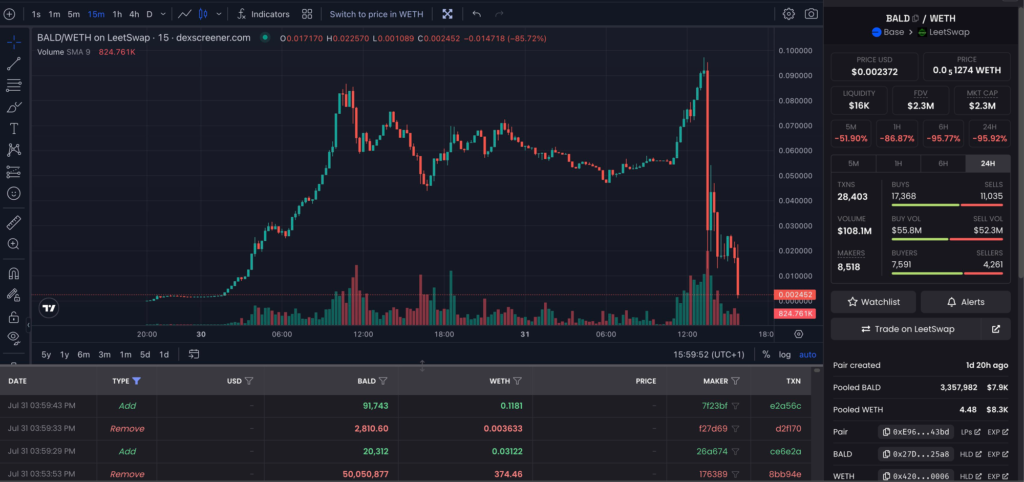What Is Exit Liquidity and How to Avoid It

Exit liquidity is a well-known term in the world of cryptocurrencies and NFTs. It refers to the situation where investors become trapped after buying an asset at its peak price, while early investors have already sold off their assets. Exit liquidity poses a significant risks in crypto investment, especially during a bull market. However, you can avoid falling victim to it by understanding what exit liquidity is. Find more information about the term in the following article.
Article Summary
- 🤑 Investors become exit liquidity when they buy assets sold by early investors at high prices, facilitating the smooth exit for early investors to cash out of their tokens.
- 🔎 Common scenarios to turn investors into exit liquidity are initial offerings, pump & dumps, rug pulls, and wash trading.
- 😖 An example of recent exit liquidity is the rug pull on the BALD token. Investors who bought at the top became exit liquidity after the developers withdrew all their funds.
- 💪 Doing in-depth research, avoiding FOMO, applying strict risk management, and using trusted exchanges are ways to prevent became exit liquidity.
What is Exit Liquidity?
As we know, markets work based on liquidity or the amount of money available in the market. High liquidity allows market participants to enter and exit the market without significantly affecting asset prices. Low liquidity can significantly affect prices when market participants exit or enter the market.
In some cases, liquidity can be created and manipulated. Usually, new crypto projects are targeted because they have a small market capitalization and low liquidity. Investors with large ownership portions, known as whales, can exploit these conditions.
Whales will not sell their assets when liquidity is low to avoid a crash. Therefore, they will get around this by increasing its liquidity. To do this, they create hype for the assets they want to sell. If successful, the hype can attract investors due to fear of missing out (FOMO).
As there are standby buyers, whales can sell their assets without worrying that the price will fall significantly. After the whales sell their assets, the price slowly starts to fall.
If the standby buyers continue to hold or sell their assets late, they could lose money because they bought them at a high price. This type of investor is referred to as exit liquidity. So, exit liquidity can be summarized as investors who buy assets sold by early investors at high prices, facilitating the smooth exit for early investors to cash out of their tokens.
Greater Fool Theory
The concept of exit liquidity can be analyzed using the greater fool theory. This theory argues that the price of an overvalued or even an asset with no fundamentals will continue to rise as long as the owner can sell it to a “greater fool.” However, when no greater fools are left, the asset price will inevitably fall.

In the context of exit liquidity, investors who become exit liquidity are considered as greater fools. They can avoid exit liquidity if they can sell their assets to other potential “exit liquidity” or greater fools.
But if they realize the situation too late, they cannot sell their assets. This is because no more market participants become greater fools to buy their assets. Many victims of exit liquidity end up being “stuck” and forced to make huge losses.
Exit Liquidity Scenario
A variety of scenarios lead an investor to end up as a liquidity exit. The following are some common scenarios that often occur:
1. Initial Offerings
New crypto projects often use the Initial Coin Offering (ICO) or Initial DEX Offering (IDO) process to raise funds. If investors don’t do their research carefully, they may buy tokens with no value.
When the token is listed on an exchange, and the early investors and core team sell their holdings, the investors will become exit liquidity for them. Moreover, when there is no demand from other buyers, the asset price will fall and potentially increase losses.
This article will help you understand how IDOs work and how to participate.
2. Pump & Dump
Pump-and-dump is the most common scenario used to find exit liquidity. It works by manipulating the price of an asset through coordinated buying and shilling on social media. During this phase, the asset’s price will increase .

After the price rises significantly, the early investors will sell their assets and make a profit. The asset price then undergoes a gradual correction (dump). If investors buy in the pump phase and only sell in the dump phase, they become exit liquidity.
3. Rug Pulls
The rug pulls scenario is a more harmful version of the pump-and-dump. In rug pulls, the developer or whale will suddenly withdraw all their funds from their liquidity pool, making the token worthless.
Unlike pump-and-dump, investors cannot cut losses in a rug pulls scenario. In a rug pull, the investor becomes exit liquidity for the irresponsible development team.
4. Wash Trading
Wash trading scenarios are more prevalent in NFT trading. It is a manipulative practice of repeatedly buying and selling the same asset, resulting in fake trading volumes. The same person manages the address of the buy and sell transaction.
This is done to create the illusion of liquidity or increase the value of a particular NFT collection. When investors fall for the illusion and buy the NFT collection, they become the wash trading liquidity exit.
Find out about wash trading scenarios and how to avoid them in the following article.
Exit Liquidity Example
An example of exit liquidity that shook the crypto community recently was the rug pull executed by the BALD token. It is a meme token created by an anonymous developer (The Boss) operating on the Base network.
The Boss created BALD on July 29, 2023. The next day, he gradually added more than 100 ETH to the BALD liquidity pool until it reached 6,187 ETH. On July 31, he injected another 1,150 ETH into the market. As a result, the BALD price rose from 0.05455 to 0.09578. Since its launch, the price of BALD has increased by more than 4,000%.

Following a series of price increases, The Boss abruptly withdrew 10,705 ETH from the BALD liquidity pool, amounting to roughly 20 million US dollars. This caused a sharp decline of 92% in the price of BALD on July 31, 2023, as shown in the image above.
The BALD token is an example of exit liquidity with a rug pull scenario. For investors who bought BALD tokens on July 30 and were late to take profit or cut loss, they became victims of exit liquidity from The Boss.
How to Avoid Becoming the Exit Liquidity
Here are some ways to avoid becoming the exit liquidity:
1. In-depth Research
Conducting thorough research is the key to not ending up as a victim of exit liquidity. Find out which team is responsible for the project. Make sure the team contains experienced figures and has a clear track record. Also, make sure the project has a clear roadmap. This shows the team’s seriousness in developing the project in the long term.
Another research that can be done is to dissect the tokenomics or whitepaper of the project. Avoid projects that have red flags, such as unbalanced token allocation, unclear use cases, and vague schedules.
Find out how to break down tokenomics in depth through this article.
2. Pay Attention to The Vesting Schedule and Token Unlocks
Venture capitalists and whales love to dump on careless investors. Therefore, pay attention to the vesting schedule and token unlocks to determine the potential for massive token sales in the future.
If there is no schedule or the date is vague, it indicates a red flag. The developers might dump their portion. The token launch and distribution schedule should be announced, updated regularly, and easily accessible to the public.
3. Watch Out for FOMO
All liquidity exit scenarios involve the Fear of Missing Out (FOMO) factor. Therefore, ensure not to get trapped and decide to invest based on FOMO.
Another way to avoid FOMO is to monitor news and sentiment related to the asset. You can move quickly if things go wrong by always being up to date with the latest news.
4. Apply Risk Management
If you want to profit from small-cap tokens, you should not use all your capital. Allocate capital according to your risk tolerance. Assume that if all your capital is gone, you can accept it.
To ensure the right exit strategy, you should use technical analysis. It helps determine the target price to take profits or stop losses to limit losses. A clear strategy and strict risk management can help you avoid the exit liquidity trap.
Learn here to be able to do risk management more strictly.
5. Use Trusted Exchange
On a trusted exchange, the traded assets have gone through a rigorous selection first. It is eliminating tokens with unclear backgrounds. Pintu is one of the trusted crypto exchanges regulated by the government. Pintu also diligently evaluates all its crypto assets, highlighting the significance of being cautious.
Conclusion
Exit liquidity refers to investors who buy assets sold by early investors at high prices, facilitating the smooth exit for early investors to cash out of their tokens. Some common exit liquidity scenarios are initial offerings, pump & dumps, rug pulls, and wash trading.
To avoid becoming exit liquidity, it is advisable to do in-depth research, pay attention to vesting schedules and token unlocks, be wary of FOMO, use strict risk management, and choose a trusted exchange. These steps aim to avoid buying overvalued assets that could cause you to lose money.
Buy Crypto Assets on Pintu
Looking to invest in crypto assets? No worries, you can safely and conveniently purchase a wide range of cryptocurrencies such as BTC, ETH, SOL, and others safely and easily on Pintu. Pintu diligently evaluates all its crypto assets, highlighting the significance of being cautious.
Pintu is also compatible with popular wallets such as Metamask to facilitate your transactions. Download Pintu app on Play Store and App Store! Your security is guaranteed because Pintu is regulated and supervised by Bappebti and Kominfo.
Aside from buying and trading crypto assets, you can expand your knowledge about cryptocurrencies through various Pintu Academy articles. Updated weekly, all Pintu Academy articles are made for knowledge and educational purposes, not as financial advice
References
- Adam Hayes, Understanding Liquidity and How to Measure It, Investopedia, accessed on 3 January 2024.
- Adam Hayes, Greater Fool Theory: What It Means in Investing, With Examples, Investopedia, accessed on 3 January 2024.
- Taisiia Prosvirova, What Is Exit Liquidity in Crypto and How to Avoid Becoming One, Coin Paper, accessed on 3 January 2024.
- Lyle Daly, What is a Cryptocurrency Exit Scam? The Motley Fool, accessed on 3 January 2024.
Share
Related Article
See Assets in This Article
PUMP Price (24 Hours)
Market Capitalization
-
Global Volume (24 Hours)
-
Circulating Supply
-


